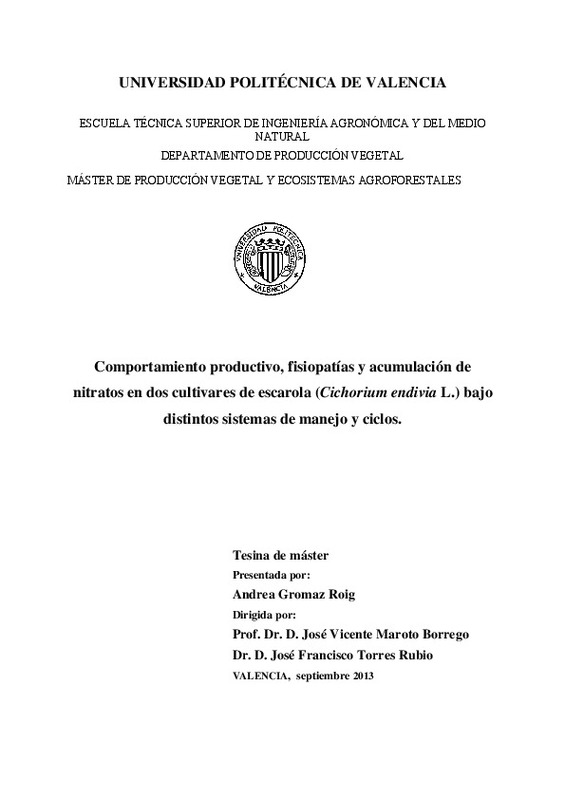|
Resumen:
|
[ES] Los objetivos de este trabajo han sido:
Estudiar, sobre dos cultivares de escarola de hoja lisa, la influencia de dos niveles de humedad (control y túnel) y dos modalidades de cultivo (aire libre e invernadero) sobre ...[+]
[ES] Los objetivos de este trabajo han sido:
Estudiar, sobre dos cultivares de escarola de hoja lisa, la influencia de dos niveles de humedad (control y túnel) y dos modalidades de cultivo (aire libre e invernadero) sobre la producción e incidencia de diversas fisiopatías (¿tipburn¿, subida a flor prematura, mancha translucida), así como en la acumulación de nitratos en las hojas, en dos ciclos distintos (C1 primaveral y C2 estival).
Determinar si existe una relación entre el contenido de nitratos y los parámetros de color de la escala HunterLab, entre el contenido de nitratos y los valores de SPAD, así como entre los parámetros de color y la medida de SPAD.
Los resultados obtenidos indicaron que:
- Las altas temperaturas y una humedad relativa baja (invernadero y humedad control) resultaron ser las condiciones más propicias para la aparición de `tipburn¿. En dichas condiciones, el cultivar `Natacha¿ presentó más sensibilidad a esta fisiopatía que el cultivar `Cuartana¿.
- El cultivo en condiciones de menor restricción lumínica favorecieron la subida a flor de las plantas, siendo el cultivar `Cuartana¿ el que se mostró más proclive a esta fisiopatía.
- Los valores de humedad y temperatura que se dieron en el ciclo C1 resultaron ser los más favorables para el cultivo de esta especie, obteniéndose en dicho ciclo, un mayor porcentaje de plantas comerciales que también alcanzaron un mayor peso.
- Los valores más altos del SPAD se obtuvieron en el ciclo C2, siendo el cultivar `Cuartana¿ y el cultivo al aire libre los que presentaron los valores más elevados.
- En el ciclo C2 con una temperatura e iluminación más altas que en el ciclo C1 el contenido en nitratos fue más elevado.
- Durante el ciclo C1, para el cultivar `Cuartana¿ y la producción en invernadero se alcanzaron los mayores contenidos en nitratos.
- El ciclo en el que las plantas presentaron un mejor desarrollo, la mancha translúcida se
dio con mayor intensidad, afectando en mayor grado al cultivar `Natacha¿.
- Se halló una clara relación entre los parámetros de color y la concentración de nitratos, así como entre los valores de SPAD y la concentración de nitratos aunque mostraran una débil correlación lineal.
[-]
[EN] The objectives of this work were:
Studying on two cultivars of endive, the influence of two humidity levels (control and tunnel) and two crop systems (outdoor and greenhouse) on the production and incidence of various ...[+]
[EN] The objectives of this work were:
Studying on two cultivars of endive, the influence of two humidity levels (control and tunnel) and two crop systems (outdoor and greenhouse) on the production and incidence of various physiological disorders (`tipburn¿, bolting and glassines) and nitrate accumulation in leaves, in two crop cycles (Cycle 1 spring and Cycle 2 summer).
Determine whether there is a relationship between the content of nitrate and color parameters of HunterLab scale, between the nitrate content and SPAD values and between color parameters and SPAD values.
The results indicated that:
- High temperature and low relative humidity (greenhouse and humidity control) were the most favorable conditions for the appearance of ' tipburn '. In these conditions, cultivar `Natacha ' showed more sensitivity than the cultivar ' Cuartana ' .
- The growth in conditions of high light intensity favored bolting and cultivar `Cuartana¿ was the more susceptible.
- The conditions of humidity and temperature that occurred in the cycle C1 were the most favorable for the growth of these plants. In this cycle, the percentage of commercial plants was higher than in the cycle C2, and their weight was higher too.
- In the cycle C2, the SPAD values were higher than in the first cycle (C1). Cultivar `Cuartana¿ and outdoor conditions showed the most elevated values.
- In the cycle C2 with high temperature and a higher light intensity, the content of nitrate reached was superior.
- In the cycle C1, the highest nitrate content was given with cultivar `Cuartana¿ and greenhouse cultivation.
- When plants growth occurred in the best conditions, the glassines was more severe and cultivar Natacha was the most affected.
- Color parameters and nitrate content were clearly related, as well as values of SPAD and nitrate content, althought the lineal correlation was poor.
[-]
|







